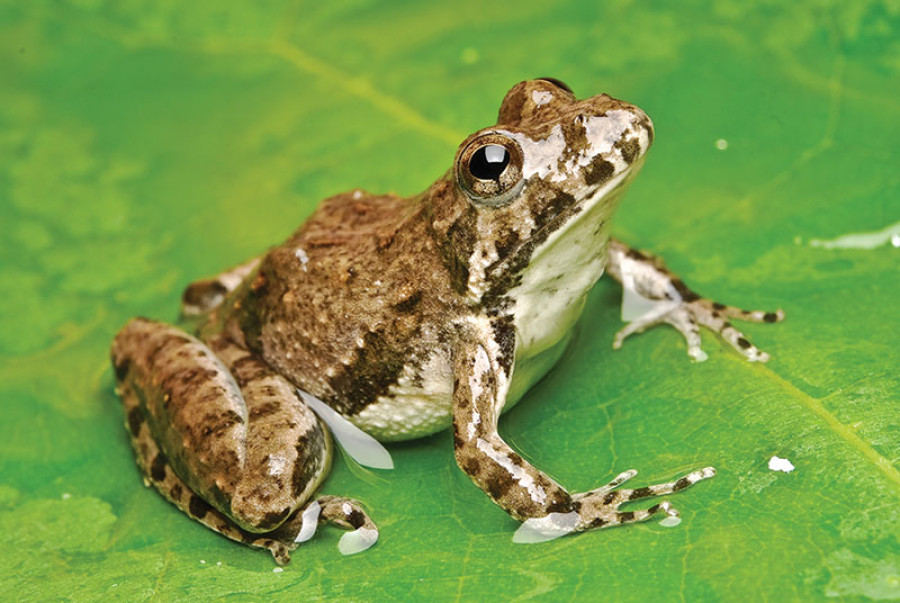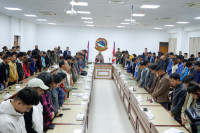Opinion
Save the frogs
Million of frogs are killed for dissection in biology lab. Every year in Nepal, science students cut open 50,000 to 100,000 frogs in Grade XI to study the anatomy of vertebrates. And that is futile. Frogs are one of the oldest vertebrates on this planet.
Biraj Shrestha
Million of frogs are killed for dissection in biology lab. Every year in Nepal, science students cut open 50,000 to 100,000 frogs in Grade XI to study the anatomy of vertebrates. And that is futile. Frogs are one of the oldest vertebrates on this planet. They have survived four mass extinctions, but currently they face rapid decline mostly due to habitat loss, pollution, pesticide use, climate change, over harvesting for food, collection for dissection and experimentation, disease, shrinking water sources, lack of conservation awareness and so forth. This has caused the extinction of hundreds of species worldwide.
About one-third of the total amphibian population is threatened with serious risks of extinction. According to the IUCN Red List of Threatened Species, the percentage of threatened amphibian species is above 40 percent, and that’s way higher than for mammals (25 percent) and birds (13 percent). Dissection is a major reason behind the disappearance of frogs. In Nepal, four major species, namely the tiger frog which is listed in Appendix II of CITES (Convention on International Trade in Endangered Species of Wild Fauna and Flora), Nepal cricket frog, Tarai cricket frog and skittering frog are highly exploited for dissection.
Knowingly or unknowingly, the existence of frogs living in close proximity to humans has benefitted us in a multitude of ways. First, tadpoles (the larval stage of amphibians) help in cleaning water resources by consuming organic debris and algae enriching the oxygen content of the water. The adult frog then helps to check vector borne disease carrying insects like mosquitoes and flies. They are also a source of food for many predators like snake, hawk, jackal and wild dog, thus helping to balance the ecosystem. Farmers have always regarded frogs as their friend because they help to control pest infestation that destroys their crops. Scientists know that diminutive animals like amphibians serve as an alarm to humans by playing an exceptional role as bio-indicators. The Newar community has revered frogs from eons as their saviour in the effort to get rid of the mythical demon Ghantakarna.
Anti-dissection protests came to the fore in 1987 when a California student, Jennifer Graham, refused to dissect a frog in her biology practical class. She sued the school demanding an alternative to dissecting frogs. The court ruled in her favour and the verdict gave birth to a state law which allowed students to decide whether to opt for dissection or not. Today, nearly 17 states in the US have passed laws in favour of the student’s opinion regarding animal dissection. In India, the Central Board of Secondary Education in conjunction with the University Grant Commission has revamped biology curriculums, freeing students from having to dissect frogs. Grade 12 students of St Mary’s High School said in a questionnaire-based interview taken in 2017 that they felt guilty about learning anatomy in a manner that causes the death of frogs.
Be sensible
Indeed dissecting frogs merely teaches the young generation that it is okay to mistreat animals and show no respect for other forms of life. Frogs used in biology lab are preserved in containers with a hazardous chemical called formalin, which is toxic to humans. Most of the frogs used in biology lab are collected from the Tarai lowlands, directly from the wild as Nepal does not have farm-raised frogs for utilitarian purposes. India stopped exporting frogs for commercial use due to growing animal rights movements.
This does not mean that we should start raising frogs in captivity as captive bred frogs are highly prone to diseases; and if they escape, they may be detrimental to local frog species. With growing concern for frog welfare, the West has come up with a splendid substitute to animal dissection through the use of dummy models, audio-visual teaching and virtual dissection software. This is not only economical as the software once installed can be reused multiple times, but also keeps the biology lab free of toxic fumes and scalpels. A zoology lecturer at Pinnacle Academy says that frogs should not be killed just for one single lesson in biology class, and strongly advocates using computer simulation for teaching in the future.
Whether the plight of frogs being sacrificed in the name of dissection gets further attention
from policymakers in Nepal’s education sector or not, it is still a prime concern to ensure the survival of frog populations. Remember that, every year, frogs wait for hundreds of days to come out of hibernation with the hope of continuing their next generations only to fall into the trap of hunters. So, raise your voice to save frogs.
Shrestha holds a Master’s degree in environmental science from Khwopa College, Bhaktapur




 11.12°C Kathmandu
11.12°C Kathmandu










